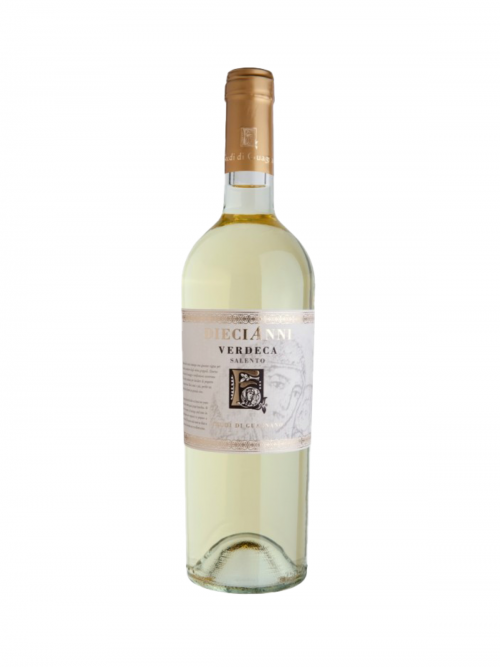

Verdeca is one of the historical Puglia grape varieties. Its name comes from the particular pale green colour of the grape, which is also typical of the wine. The best type of soil for verdeca is shallow calcareous rock. In the glass the nose shows hints of green apple, lemon and star anise. Sensations of salt with good balance and finesse on the palate.
TASTING BOX INCLUDES:
2 BOTTLES OF NERO DI VELLUTO NEGROAMARO SALENTO IGP 2020
2 BOTTLES OFCUPONE SALICE SALENTINO NEGROAMARO RISERVA DOP 2021
2 BOTTLES OF LE CAMARDE NEGROAMARO&PRIMITIVO SALENTO IGP 2021
Tradition and respect for the land can be found in this riserva wine. Cupone has a unique and austere character obtained by using grapes from old negroamaro bush-vines. A particularly bright and full-bodied red wine; hints of tobacco, nuts and Mediterranean herbs on the nose; soft tannins and balsamic hints on the palate.
Hand-painted wooden box by the artists Mario Miccoli and Nadia Verrienti that reproduces the profile of a woman with her blonde hair adorned with typical southern fruits: grapes, lemons, tangerines. The box contains a bottle of Le Camarde Negroamaro&Primitivo IGP Salento, one of Cupone Salice Salentino Negroamaro Riserva Dop and one of Nero di Velluto Negroamaro IGP Salento.
WHAT DOES IT CONSIST OF?
The "Signor Negroamaro" experience includes the tasting of 3 wines (Rosarò Rosato Salice Salentino Negroamaro DOP + Cupone Salice Salentino Negroamaro Riserva DOP + Nero di Velluto Negroamaro Salento IGP + Final Surprise) paired with traditional Apulian bakery goods (tarallini, friselle etc.)
1 person € 16,00
From 2 to 15 people €15.00 per person
Minimum 1 maximum 15 people
For groups of more than 15 people, ask for a quote.
The denomination Salice Salentino Negroamaro is one of the first born in Puglia: in fact, it was established in April 1974. The geographical area dedicated to the production of this important DOP includes a total of 7 municipalities in Northern Salento including Guagnano. The Diecianni Salice Salentino Negroamaro has a compact red color with delicate garnet hues. The sensory profile is complex: it ranges from the typical notes of tobacco and vanilla. In the mouth it expresses sensations of bitter almond on a powerful tannin. Of these magnums, vintage 2016, only 762 bottles were produced and they are all sold with a certificate of authenticity.
Cardboard packaging finished with a print of a detail of the "Negramanti" painting located in the tasting room of the Feudi di Guagnano winery. The box contains a bottle of Pietrafinita Primitivo di Manduria Dop, one of Cupone Salice Salentino Negroamaro Riserva Dop and one of Nero di Velluto Negroamaro IGP Salento.
Cuccimanne' is the abbreviated name by which the wagtail is know in Salento, a small bird present in the Susumaniello vineyards.
Wine with a pale pink colour. On the nose it releases Mediterranean fruits. In the mouth it presents notes of currant and raspberry.
Hand-painted wooden box by painters Mario Miccoli and Nadia Verrienti that reproduces the profile of two "wine lovers". The box contains a bottle of Le Camarde Negroamaro&Primitivo IGP Salento, one of Cupone Salice Salentino Negroamaro Riserva Dop and one of Nero di Velluto Negroamaro IGT Salento.
Wooden box finished with a print of a detail of the painting "I Negramanti" located in the tasting room of the Feudi di Guagnano winery. The box contains a bottle of Pietrafinita Salento IGT, one of Cupone Salice Salentino Negroamaro Riserva Doc and one of Nero di Velluto Negroamaro IGT Salento from the historic vintage selection.
In Salento, the celebration wine of choice is Malvasia Nera. DieciAnni Malvasia Nera is a single varietal wine vinified without any contact with oak in order to enhance the natural fragrance of the fruit. DieciAnni Malvasia Nera is an intense ruby-red colour wine; on the nose are hints of dewberry, blood orange and violet. The palate is fresh with hints of cherry and blueberry. The wine is mouth-filling with supple tannins.
One of the most intriguing and fascinating negroamaro. This is why it is always worth keeping a good supply in the cellar to drink a glass of it at the right time. It is a wine with an intense red colour. The nose explodes with hints of carob and raisins. In the mouth it has spicy notes of black pepper and tobacco. The finish is long and structured. The first vintage produced was 2002 in 2,298 bottles. All bottles are numbered by hand. In the vintage of 2013, only 380 magnum bottles were produced, all numbered by hand and all are sold with a certificate of authenticity.
Packaged in an elegant cardboard case containing a bottle of Diecianni Primitivo Salento IGT decorated with a satin bow. The package can also contain other bottles from the Feudi di Guagnano catalogue and can be set up with customized labels. For different packaging and decorations, ask for a quote by calling 0832705422 or writing to contact@feudiguagnano.it
Wedding favor composed with a bottle of Diecianni Negroamaro Salento IGT decorated with an elegant satin bow. The wedding favor can also be composed with other bottles from the Feudi di Guagnano catalogue and can be set up with customized labels. For different packaging and decorations, ask for a quote by calling +39 832705422 or writing to contact@feudiguagnano.it

Verdeca is one of the historical Puglia grape varieties. Its name comes from the particular pale green colour of the grape, which is also typical of the wine. The best type of soil for verdeca is shallow calcareous rock. In the glass the nose shows hints of green apple, lemon and star anise. Sensations of salt with good balance and finesse on the palate.
This site uses cookies, including third-party cookies, to improve your browsing experience and for analytical and marketing purposes. You can accept all cookies or manage your preferences. For further details, please see our Cookie Policy